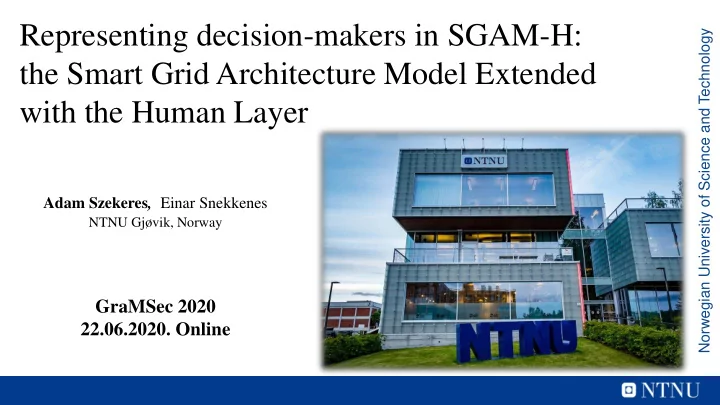

Representing decision-makers in SGAM-H: Norwegian University of Science and Technology the Smart Grid Architecture Model Extended with the Human Layer Adam Szekeres , Einar Snekkenes NTNU Gjøvik, Norway GraMSec 2020 22.06.2020. Online
Motivation • Safety and security of societies depends on critical infrastructures • Traditional electric grid enhanced by IoT devices has an increased attack surface • Smart Grids are emerging, complex and dynamic systems which pose several challenges for most risk analysis methods • Unrealistic expectation: comprehensive risk analyses can be conducted on real systems • Security is about human motivation Introduction – Methodology – Human Layer – Case study – Conclusion 2
Motivation – potential threats to Smart Grids Human error Non-compliance Motivated attack(er)s Negative externalities (weakest link) (unintended side effects of operating in a complex environment, exposure to others’ decisions) Limited Lack of Insiders cognitive awareness Hackers capacities Lack of skills IoT botnets Stakeholders: Network convergence Forgetfulness Goal conflicts Cyber-attacks legislators, Economic constraints governmental agencies, Task-related Ransomware First to market vs. standardizing bodies, errors Sabotage providing secure devices data protection authorities, Espionage organizations focusing on the and software DDoS generation, Privacy violations … transmission, … distribution of electricity, equipment manufacturers, software and security providers, researchers, consumers Introduction – Methodology – Human Layer – Case study – Conclusion 3
Smart Grid Architecture Model (SGAM) * • Capture complexity of Smart Girds in a technology-neutral way • Establish common understanding among stakeholders about the systems • Represent stakeholders, applications, systems and components that will have to achieve efficient interdependent operations • Human decision-makers are not represented in the model *CEN-CENELEC-ETSI Smart Grid Coordination Group: Smart grid reference architecture (2012) Introduction – Methodology – Human Layer – Case study – Conclusion 4
Conflicting Incentives Risk Analysis (CIRA) method * - risk owner II I Cooperation Opportunity Risk - strategy owner • Risk is the result of misaligned incentives • Replacement of incident Avoidance probability/likelihood estimations with strength of human motivation Consensus Threat Risk • Does not rely on historical data III IV *Rajbhandari , L. and Snekkenes, E. (2013). Using the conflicting incentives risk analysis method. In IFIP International Information Security Conference, pages 315 – 329. Springer. Introduction – Methodology – Human Layer – Case study – Conclusion 5
Methodology – Design Science Research * Establish Literature review, Graphical Hypothetical Identification of connection representation case study between existing solutions in of extracted (qualitative, need of improvement descriptive CIRA and abstract SGAM Concept extraction concepts method) * Hevner, A.R.: A three cycle view of design from relevant science research. Scandinavian journal of scientific articles information systems 19(2), 4 (2007) Introduction – Methodology – Human Layer – Case study – Conclusion 6
Human Layer Introduction – Methodology – Human Layer – Case study – Conclusion 7
Case study Focusing on intra-organizational risk experienced by CEO of a Distribution System Operator (DSO) Balanced Scorecard (BSC) method used for identifying key utility factors (KPIs) of the CEO Strategy identification by analyzing key processes and functions at DSOs. Key issues covered: - privacy, - fulfillment of societal roles (education and safe streets), - conflict between goals of information security and business objectives Introduction – Methodology – Human Layer – Case study – Conclusion 8
Case study Introduction – Methodology – Human Layer – Case study – Conclusion 9
Conclusions • Internal evaluation of the artifact (1-5): Efficacy (fulfillment of specified goal): 5 Ease of use: 3 Completeness (representing key CIRA concepts): 5 Homomorphism (correspondence with original SGAM): 4 • Facilitate construction of a common understanding among stakeholders about the importance of including people in Smart Grid models • Improve context establishment, risk communication Introduction – Methodology – Human Layer – Case study – Conclusion 10
Conclusions • Future work: increase compatibility with original SGAM objects, software tools to improve scalability, simulations with a higher number of stakeholders populating the SGAM-H, field experiments to refine the models Important step towards a more balanced understanding of risks in complex systems by focusing on conscious human decisions and establishing the methodology for assessing key attributes of people Introduction – Methodology – Human Layer – Case study – Conclusion 11
Thank you for your attention! adam.szekeres@ntnu.no 12
Recommend
More recommend